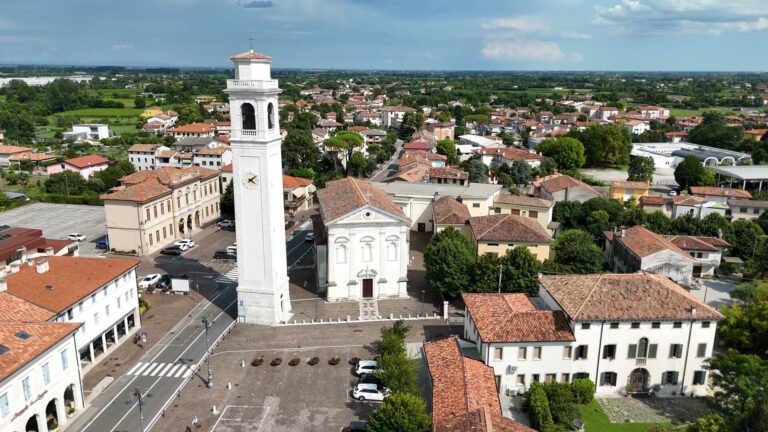ARTISTS’ ROADS
LE VIE DEGLI ARTISTI
watch the videos at the bottom of the page!
ORSAGO
Orsago: Saints, Landscape, Serenity
The life of works of art is not always easy.
They are objects that live in the matter from which they are made, and they must adapt to the contexts that host them.
The altarpiece in the parish church of Orsago, depicting Saints Roch and Sebastian, is an interesting example of one of these not infrequent adaptations.
Its current placement dates to the 1840s.
At that time, the canvas was expanded to be set into a new marble retable, and the wide landscape that frames it was added.
But this enlargement, almost a doubling, revealed an empty sky, which was filled with the figure of a little angel holding the palm of martyrdom.
It is quite large, and it changed the composition.
Below, a crouching dog, the traditional attribute of St. Roch, was added.
The original work corresponds to the central portion only, smaller, and meant to fit within a wooden altar, now lost.
Painted in the early seventeenth century by Gaspare Narvesa, an artist active mainly in the Pordenone area, the work employs a palette derived from Paolo Veronese, while its forms and composition recall Titian.
It offers an intriguing example of how Titian’s painterly language endured in this region, holding back the spread of the Baroque with its twisted figures, otherworldly visions, and pastel colours.
Here we find together the two saints most often invoked against the plague, whose thaumaturgic power, and thus their iconographic success, was widespread throughout the Veneto.
This painting predates the wave of devotion that would arise just a few years later, during the plague of 1630, when Venice urged communities across the region to create shrines or images in thanksgiving to Mary or to the two healing saints for their deliverance from danger.
The faces are striking portraits.
Both saints gaze upon St. Roch’s wound, but there is no drama. Even St. Sebastian, pierced by a single arrow, shows no pain.
This is the sacred rendered as everyday life. There is nothing otherworldly about it, which is also why the little angel bearing the palm seems like a dissonant note.
Sebastian’s nude, muscular body follows the stylistic canons of Mannerist painting.
But its Michelangelesque monumentality is softened by Titian-like brushwork.
St. Roch’s pose is natural, unforced. His clothing, by contrast, is a bold display of vivid colours: blue, green, and pink.
The landscape is soft and descending: a narrow lane winds among the hills, and the clouds linger over the highest peaks.
The landscape is a subject in its own right. It is a real place, one that makes the saints’ presence feel real as well.
MORE EXPERIENCES!
Il Sacro per la salvezza:
- Giovanni Zanzotto, oratorio del Carmine a Pieve di Soligo.
- Cristo della Domenica, pieve di San Pietro di Felletto.
- Francesco Beccaruzzi, arcipretale di Mareno di Piave.
- Giovanni Marchesi, parrocchiale di San Vendemiano.
MULTIMEDIAL MAP: “ARTISTS’ ROADS – LE VIE DEGLI ARTISTI- EN”!

